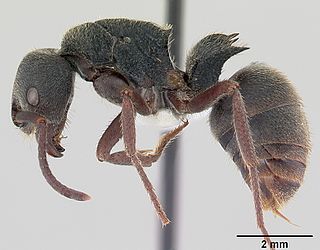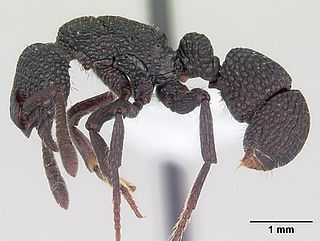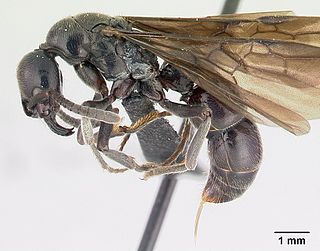
Ponerinae is a subfamily of ants in the Poneromorph subfamilies group, with about 1,600 species in 47 extant genera, including Dinoponera gigantea - one of the world's largest species of ant. Mated workers have replaced the queen as the functional egg-layers in several species of ponerine ants. In such queenless species, the reproductive status of workers can only be determined through ovarian dissections. Ponerinae is a subfamily of ants within the family of Formicidae. These ants typically nest in soil, forest litter, or rotting logs, and are predacious. They primarily prey on isopods. They mostly live in small colonies of up to 200 workers. They can be found mostly in tropical environments, but have been found in southeastern Canada and New York. Female workers have twelve segmented antennae, whereas male workers have 13 segmented antennae.

Phrynoponera pulchella is a species of ant in the subfamily Ponerinae. It was discovered and described by Bolton, B. & Fisher, B. L. in 2008.

Feroponera is a monotypic Afrotropical genus of ants in the subfamily Ponerinae containing the single species Feroponera ferox. The genus is known only from a few specimen collected from an unoccupied termitary in Cameroon.

Centromyrmex is a pantropical, though mainly Afrotropical, genus of ants in the subfamily Ponerinae. This ponerine ant was recorded for the first time in French Guiana and the most northerly point of recording was in Costa Rica. The specimens reported here were collected in a region of Amazon Forest with flight interception traps.

Hypoponera is a genus of ants in the subfamily Ponerinae. The genus has a worldwide distribution and is found in all continents except Antarctica.

Plectroctena is an Afrotropical genus of ants, with most species occurring in the rainforest zones of West and Central Africa. Some species are cryptic or subterranean foragers, while others forage in open grassland terrain. The workers forage singly or in groups of 2 to 3. They nest in the earth at varying depths, or in collapsed logs. They prey mainly on millipedes, including their young or eggs.

Loboponera is an Afrotropical genus of ants in the subfamily Ponerinae with nine recognized species. The genus is found in central and western Africa, from Ivory Coast to Rwanda. Little is known about their biology.

Vicinopone is a monotypic Afrotropical genus of arboreal ants in the subfamily Dorylinae. Vicinopone conciliatrix, the only species in the genus, was first described as Simopone conciliatrix by Brown in 1975 and was transferred to its own genus by Bolton & Fisher in 2012. V. conciliatrix appears to be quite widely distributed but rare. Its rarity is more likely apparent than real because it nests and forages in trees, rarely if ever coming down to the ground.

Paraparatrechina is a genus of small ants in the subfamily Formicinae. The genus contains 31 species distributed in the tropics of Africa, Asia and Australia.

Boloponera is a genus of small ants in the subfamily Ponerinae. The genus contains the single species Boloponera vicans, known from a single worker specimen collected in leaf litter in the Central African Republic. It is sometimes referred to as Bry's Ant after its discoverer, Brian Fisher.

Leptogenys is a genus of ants in the subfamily Ponerinae. Leptogenys is the most diverse ponerine ant genus in the world; it is widespread throughout tropical and subtropical regions and there are over 260 extant species described. Most species have ergatoid queens, and many have falcate, bowed mandibles and are specialists on isopod prey.

Promyopias is an Afrotropical genus of ant in the subfamily Ponerinae containing the single species Promyopias silvestrii. The rare genus has previously been regarded as a separate genus, as a subgenus and as a provisional synonymy, but was reinstated at genus-rank in 2008.

Phrynoponera is a strictly Afrotropical genus of ants in the subfamily Ponerinae.

Bothroponera is a genus of ants in the subfamily Ponerinae. It is distributed in Africa and Asia.

Phrynoponera gabonensis is an Afrotropical species of ant in the subfamily Ponerinae. P. gabonensis is the most common, widely distributed and frequently encountered member of the genus Phrynoponera. Specimens are usually retrieved from leaf litter samples but also occur in pitfall traps. The species is known to nest in and under rotten wood, in compacted soil and in termitaries.

Phrynoponera bequaerti is an Afrotropical species of ant in the subfamily Ponerinae. The species is almost as common and widespread as Phrynoponera gabonensis and by far the smallest species in the genus. P. bequaerti is easily recognized by its size, lack of clypeal teeth and short, broad funicular segments. Unlike P. gabonensis and P. sveni, P. bequaerti has not been found in termitaries.

Buniapone is a monotypic genus of ants in the subfamily Ponerinae. Buniapone amblyops, the single described species, is found in Southern and Southeast Asia.

Euponera is a ponerine genus of ants distributed in the Afrotropics and eastern Asia. Workers are large (6–10.5 mm); queen are similar to workers, but larger and winged.

Fisheropone is a genus of ants in the subfamily Ponerinae. Known from central Africa, it contains a single described species Fisheropone ambigua, and at least one undescribed species. Nothing is known about its biology.

Mesoponera is an Old World genus of ants in the subfamily Ponerinae. It is found in the tropics, from Sub-Saharan Africa to Australia.



















